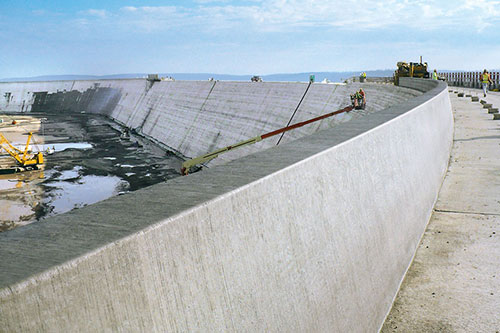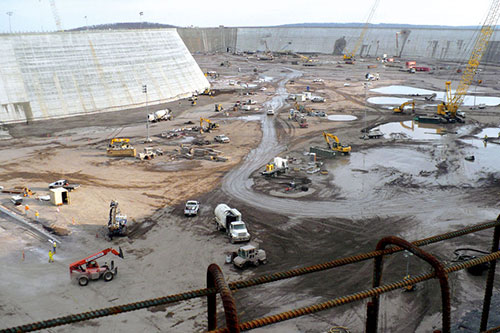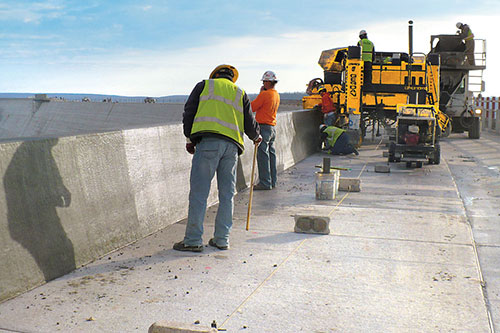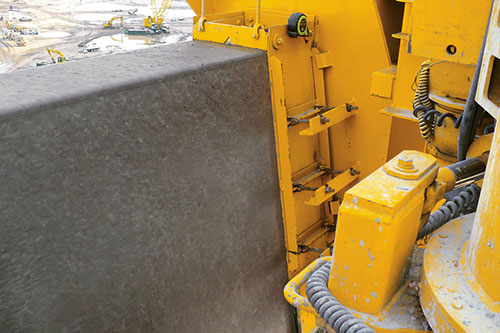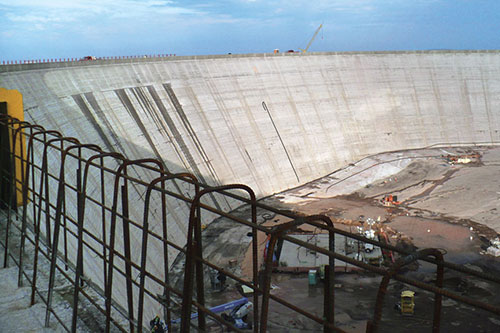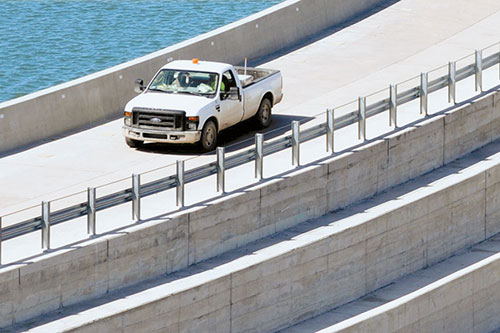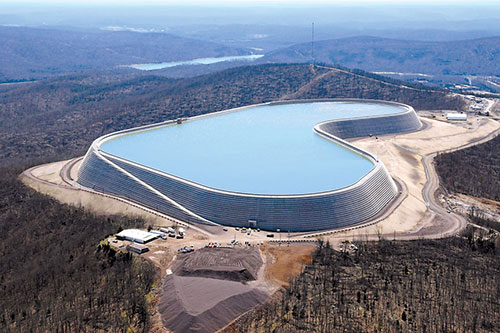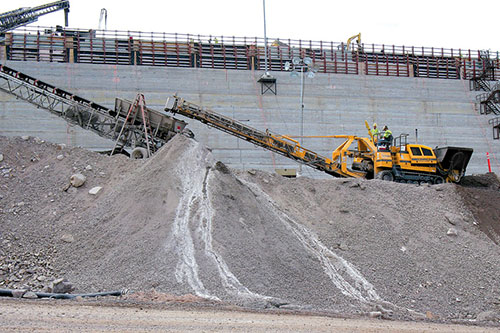GOMACO World Index --- GOMACO World 38.1 - July 2010
Slipforming Barrier Wall at New Heights
Gerdan slipforms barrier wall with their Commander III 110 feet (33.5 m) above the ground and on top of the new Taum Sauk reservoir in Missouri.
The new Taum Sauk Hydroelectric Power Station near Lesterville, Missouri, started producing power again this Spring. The new upper reservoir dam was completely rebuilt from the ground up after the structure suffered a catastrophic failure in December 2005. At the very top of the ground-up rebuild, is a new concrete safety barrier around the structure to keep both vehicular and pedestrian traffic safe. Gerdan Slipforming and their GOMACO three-track Commander III were chosen to slipform the new wall.
The Taum Sauk reservoir sits atop Proffit Mountain. On the morning of December 14, 2005, a section of wall on the northwest side of the upper reservoir failed. One billion gallons (4,000,000 m3) of water escaped the breach in twelve minutes sending a 20 foot (6.1 m) crest of water down the Black River. Amazingly, nobody was killed, but the path the water took is still a very visible scar on the side of Proffit Mountain.
Reconstruction of the upper reservoir began in late 2007. The project was awarded to Ozark Constuctors, LLC, which is a venture partnership between Fred Weber Inc., and ASI Constructors Inc., with Paul C. Rizzo Associates Inc. serving as Engineer of Record and Construction Manager.
Gerdan Slipforming, based out of Cape Girardeau, Missouri, specializes in slipforming wall on challenging projects. GOMACO World Volume 32, Issue 2, featured their work on the Bill Emerson Memorial Bridge. They slipformed the approach wall and parapet for the cable-stayed bridge. Their work was carried out from the bridge deck 60 feet (18.3 m) above the surface of the Mississippi River.
The top of the Taum Sauk reservoir takes the company to new heights... 110 feet (33.5 m). The extreme height had Dan Driskell, Project Manager for Gerdan Slipforming, concerned for his Commander III operator's stomach.
"I was worried about our operator looking down into the bowl of the reservoir from on top of the moving machine and getting queasy," he said. "Thankfully, that never happened while we were slipforming.
"The only time he got queasy was when we were tracking the machine up the ramp to get it to the top of the reservoir. He actually had to stop the Commander III, get down, and get his feet on solid ground. The ramp was very intimidating, even just walking up or down it on foot. It's very narrow and there was just barely enough room for the machine to get through."
Limited space was a challenge for the entirety of the project. With the machine in place on the top, there was no room for ready-mix trucks to pass by it for concrete delivery. Trucks also had to be carefully coordinated so they didn't meet each other on the only ramp.
"Getting the ready-mix to the machine was the most challenging aspect of the project," Driskell explained. "It was a very tight area and there was only one way in and one way out. When the trucks emptied, they had to drive all the way around the reservoir or else they had to back out. Only one truck at a time could get to the machine and careful coordination was needed so the trucks didn't run each other over at the machine or meet each other on the ramp."
Concrete was supplied by an on-site batch plant and delivered by front-discharge, ready-mix trucks. The mix design was a state of Missouri-approved concrete and slump averaged one inch (25 mm).
The 42 inch (1067 mm) tall, OSHA-approved safety barrier was slipformed over a steel cage built by Ozark Constructors. Production averaged 1172 feet (357 m) per day, even with the challenge of concrete delivery.
Gerdan's three-track Commander III slipformed approximately 5743 lineal feet (1750 m) of 42 inch (1067 mm) tall barrier wall on the project.
Finishing work behind the paver was accomplished using a work buggy. Three finishers worked from the bridge on the buggy applying a broom finish. Two inch (51 mm) deep control joints were cut into the wall every 15 feet (4.6 m) and full depth expansion joints were placed every 120 feet (36.6 m).
It took Gerdan Slipforming approximately five days to slipform the project's 5743 lineal feet (1750 m) of safety barrier with their Commander III.
"This was an amazing site for us to work at and an absolutely phenomenal job for our company," Driskell said. "The Commander III performed flawlessly in the demanding conditions. We couldn't be happier with the outcome of the project."
The $490 million rebuilding project was a success for everyone involved. Water was pumped into the rebuilt reservoir for the first time on February 27, 2010. The Federal Energy Regulatory Commission gave the final approval for "return to normal project operations" on April 1, 2010, and electricity was first generated from the new structure on April 21, 2010. It has also been recognized with an "Award of Excellence in the Constructed Project" by the U.S. Society on Dams.
Placing RCC on the Largest Dam Under Construction in North America
The Taum Sauk Upper Reservoir Rebuild Project involved the construction of a modern concrete faced symmetrical Roller Compacted Concrete (RCC) dam. The approximately 2.7 million cubic yard (2 million m3) RCC dam replaced the existing concrete lined, rock-fill dam originally built in 1963.
Ozark Constructors responsibilities included building the 6700 foot (2042 m) long, 120 foot (36.6 m) tall, and 150 foot (45.7 m) base width structure. The new dam was built in a linear fashion, first excavating the existing ryolite rock-fill dam, then repairing the base foundation, and finally placing and forming the RCC to create the upper reservoir.
Fred Weber Inc., part of the Ozark Constructors consortium, brought in their GOMACO RTP-500 rubber-tracked placer to move the RCC mix. At 35 feet (10.7 m) long, the RTP-500 has the longest placing conveyor in the industry for high-volume material placement over a long reach.
Subscribe to Receive GOMACO World Magazine
